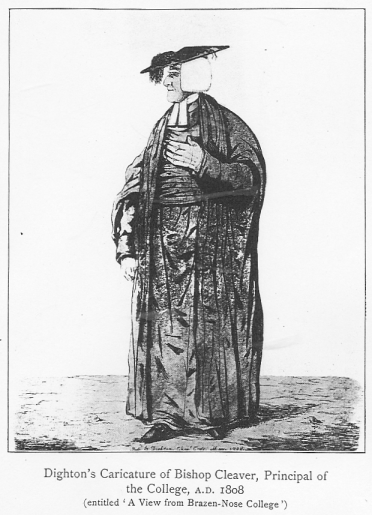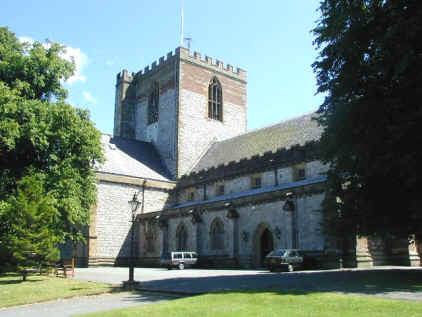William Cleaver & William Cleaver
There were two William Cleavers at Finmere.
The first was the son of a gentleman, John of Boddington, Northamptonshire. [i] After gaining a BA at Lincoln College, Oxford, Cleaver’s first living was at Twyford, Buckinghamshire. Later he was appointed Master of Buckingham School. He became Rector of Finmere after retiring from the school in 1771. He was then sixty years of age. His wife, Martha, died in May 1796 and Cleaver himself in July 1783. They are both buried at Finmere. The parish register records William’s death:
1783, July 9th. The Revd William Cleaver, A.M., Rector of this parish, and Vicar of Stowe, in the County of Bucks; whose merit and abilities were not only an ornament to his profession, but worthy of its highest honours. [ii]
While these accolades were deserved, it was his son who substantially improved church services at Finmere.
George Grenville (Nugent Buckingham) of Stowe instituted the second William Cleaver as Rector shortly after the death of Cleaver the father. The younger Cleaver had been educated at Magdalen and Brasenose Colleges, Oxford and was tutor to Buckingham, [iii] who appointed him Rector of Foscot in Buckinghamshire in 1769, then Rector of Finmere.
He proved to be an active and zealous Rector of Finmere. [iii] Before his arrival, communion had been celebrated just five times a year and Cleaver immediately increased this to eight celebrations. Musical instruments had long been absent from church services largely due to their earlier association with Catholicism and ‘Popery.’ Cleaver swept aside these concerns and introduced woodwind instruments in 1785. The instruments were a base Bassoon and an Hautbois. The latter, which translates from the French as loud or high wood, was a treble instrument first used in Paris sometime after 1650.After just a year at Finmere, and in the midst of his improvement programme, the younger Cleaver was elected Principal of Brasenose College (1785-1809). He remained Rector of Finmere despite his new responsibilities and day to day pastoral care in the parish fell to his curate, Wooley Leigh Bennett. Son of a gentleman from Elsham, Norfolk, [iv] Bennett had been appointed curate to William Senior in 1771. Cleaver was appointed Bishop of Chester in 1788, Bangor in 1800, and St Asaph in 1806. This last move was an unusual one as St Asaph is a rather poorer living than Bangor.
Cleaver died on 15 May 1815 and is buried at Brasenose.
Publications
Cleaver was a prolific publisher of sermons, letters and short works, including:
- Two Sermons by William Lord Bishop of Chester, addressed to the Clergy of the Diocese, Oxford 1789
- A Letter to the Right Rev. Dr. William Cleaver ... on the subject of Two Sermons addressed by him to the Clergy of his Diocese; comprehending also a vindication of the late Bishop Hoadly, London 1790
- List of Books for Younger Clergy, Oxford 1791
- A Sermon preached before the Lords Spiritual and Temporal, in the Abbey Church of Westminster, on Monday, January 31, 1791. Being the anniversary of King Charles's martyrdom, Oxford 1791
- Sermon for the Society for Propagation of the Gospel, London 1794
- Charge delivered by William, Lord Bishop of Chester, to the Clergy of his Diocese, Oxford 1799
- The Bishop of St. Asaph upon Lord Grenville's motion to agree with the House of Commons, in the resolutions respecting the slave trade, upon which Lord Hawkesbury had moved the previous question, 1806
Cleaver at Brasenose College
Dr Thomas Barker… was succeeded on September 10, 1785, by William Cleaver. He had matriculated at Magdalen College in 1757, and was elected to a Derbie fellowship and Brasenose on October 22, 1762. Twenty-two years later he was made prebendary of Westminster, and was promoted to the Bishopric of Chester in 1788, whence he was translated to Bangor in 1800 and to St Asaph in 1806. He has been described by De Quincey as “a wise, temperate, and successful reformer; a splendid pluralist, armed with diocesan thunder and lightning.” He was “a tall man with good features and a stately gait”; he looked (as the old Brasenose porter used to say) “quite the Bishop.” The effect too, was not a little increased by a habit of walking with both his hands upon his chest, and these hands, as in the portrait, made conspicuous by gloves of bright Bishop’s purple.
During his period of office Brasenose seems to have been a very expensive college, and the Principal himself was known to declare that “he hated a college of paupers.” Nevertheless, he was evidently most popular and respected, for on November 1, 1809, it was resolved to present him with a piece of plate “in recognition of the zeal, talent, and integrity with which he has presided over the interests of the College for 24 years, and the effects of which are testified by an unexampled increase in its members, its revenue, and his fame.”
Bishop Cleaver undoubtedly attracted many men of considerable intellectual capacity to come to the College. In 1787 Frodsham Hodson matriculated, and ultimately succeeded Cleaver as Principal. |
 |
| From Brasenose College, Quartercentenary Monographs. Vol. 7: 16th–18th Centuries. Oxford Historical Society: Clarendon Press, 1909. ‘Part 8. History of the College 1690–1803. Part II. Social Life.’ Reginald W. Jeffrey. |
Cartoon by Robert Dighton (1751-1814) |
Cleaver at St Asaph
Based on Thomas, Rev DR 1908, The History of the Diocese of St Asaph. Owestry: Caxton.

St Asaph's Cathedral is the smallest in Britain
Two features served to distinguish Cleaver's episcopate, 1806-15; his refusal to give livings with cure of souls in plurality and his constant residence in the diocese. A fresh impulse was thus given to the residence of the parochial clergy, and this foundation led to many other improvements to the fabric of churches, parsonage houses (fifteen were built in his time) and schools.
The following may refer to Cleaver's wife:
Oxford. 3rd March 1801. Saw most of the colleges—some of the buildings are very fine. Called on Mrs. Cleaver and met her walking with her three little girls; they are as hideous as herself. (Wynne Diaries III, 31).
Entries in Alumni Oxoniensis
Cleaver, Rev William, s. John of Bodington [sic], Northants, gent. Lincoln Coll., Matric. 28 march 1726, aged 15; BA 1729, MA 173?, of Twyford, Bucks, Master of Buckingham School, buried at Finmere, Oxon, 9 July 1793, father of William, Bishop of St Asaph next named and of Eusby, archbishop of Dublin, aforesaid.
Cleaver, William, s. William of Twyford, Bucks, cler. Magdalen Coll., matric 18 Oct 1757, aged 15, BA 1761; Brasenose Coll MA 1764, B&D.D. 1786, principal 1785-1809, rector of Foscot, Bucks, 1769, preb. of Westminster 1784, bishop of Chester 1788, of Bangor 1800, of St Asaph 1806, until his death 15 May 1815. Bloxham, vi.
Notes
[i] Alumni Oxonienses: The Members of the University of Oxford 1715–1886. John Foster, Oxford.
[ii] Finmere register of baptisms, marriages and burials. ORO, PAR/105/1/R1/1.
[iii] History of Finmere, J.C. Blomfield, 1887 (reprinted by Finmere and Little Tingewick Historical Society 1998) 64.
[iv] Alumni Oxonienses: The Members of the University of Oxford 1715–1886. John Foster, Oxford.

